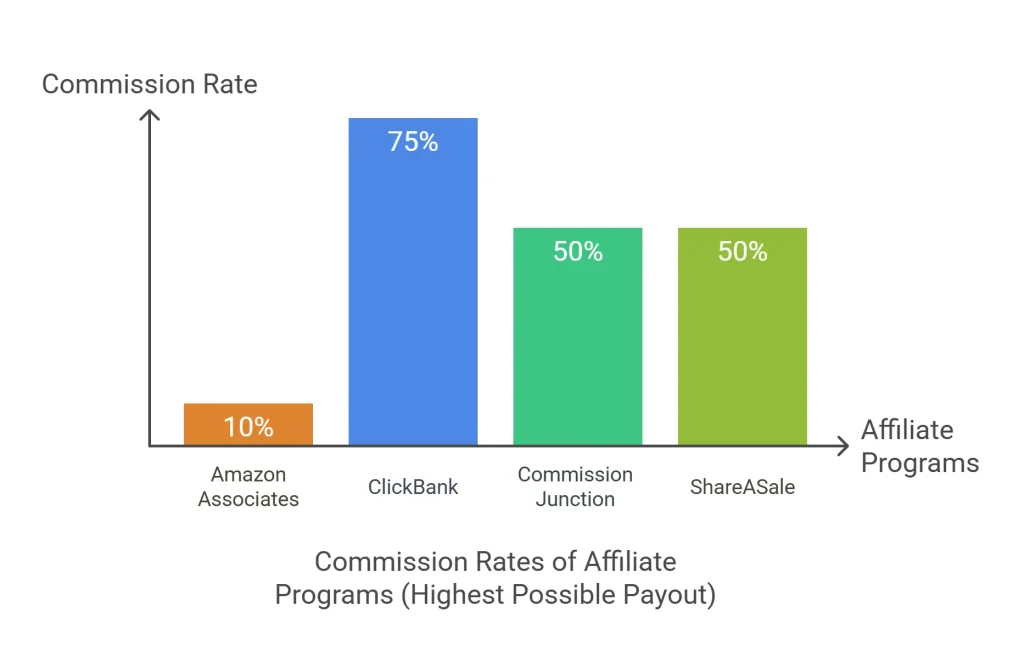
Steps to Get Started
To begin, choose a niche you’re passionate about, such as fitness or technology, and find relevant affiliate programs like Amazon Associates or ClickBank. Create a website using platforms like WordPress, produce valuable content with embedded affiliate links, and build an email list using tools like Mailchimp. Promote your content through social media and SEO, then monitor performance with analytics like Google Analytics to optimize your strategy. Start with niche selection—think trending areas in 2025 like sustainable living or AI tools. Use Google Trends or BuzzSumo to spot demand (e.g., “eco-friendly gadgets” spiking). Next, pick programs wisely: Amazon offers 1-10% commissions with a 24-hour cookie duration, while ClickBank’s digital products can pay up to 75% with 60-day cookies—longer earning windows matter. Setting up a WordPress site might cost $50/year for hosting (e.g., Bluehost) and take 10 hours initially, as one beginner found launching a yoga tips blog. Write posts like “Top 5 Yoga Mats” with links, offer a free stretching guide for email signups, and share on X or Pinterest. Track clicks in Analytics to tweak what works.
Challenges and Success Stories
Challenges include competition and building trust, but focusing on unique content and transparency can help. Success stories, like one individual earning $150,000 annually from affiliate marketing, show it’s possible with dedication. A comparison of programs is provided below to aid decision-making. Competition is fierce in niches like weight loss, but pivoting to sub-niches—like keto for seniors—cuts through the noise. Trust takes time; disclosing affiliate links upfront builds credibility. Patience is key—success might take a year, so track small wins (e.g., first $10 commission) to stay motivated. Beyond the $150,000 earner, consider a YouTuber making $50,000 yearly from tech reviews. She optimized video SEO with titles like “Best Budget Laptops 2025,” driving views and clicks. These stories prove persistence pays, turning hurdles into stepping stones with unique angles and consistent effort. Comparison Table Here’s a table comparing popular affiliate programs to help you choose:
| Program | Commission Rate | Product Variety | Payout Method |
| Amazon Associates | 1-10% | Wide range of products | Direct deposit or check |
| ClickBank | Varies (up to 75%) | Digital products | Direct deposit or check |
| Commission Junction | Varies | Various products/services | Direct deposit or check |
| ShareASale | Varies | Various products/services | Direct deposit or check |
This comparison, informed by Wishup’s list, highlights options. High commissions like ClickBank’s suit digital marketers, while Amazon’s vast catalog fits physical goods niches. Consider Rakuten Advertising (up to 10%, lifestyle focus) or Impact (tech-driven, flexible payouts) too. Pairing Amazon with ClickBank diversifies income—think gadgets and eBooks. Choose based on your audience and content style for max impact. 
Detailed Analysis and Insights
This section provides a comprehensive exploration of passive income through affiliate marketing, expanding on the key points and steps outlined above. The analysis is informed by recent research and examples, ensuring a thorough understanding for readers interested in this income stream as of March 9, 2025.
Understanding Passive Income and Affiliate Marketing
Passive income is defined as earnings generated with minimal ongoing effort after initial setup, such as rental income from properties or dividends from investments. Affiliate marketing, a performance-based strategy, involves promoting products or services and earning commissions per sale or action, as detailed in Shopify’s guide. The combination aims to create a system where promotions, like blog posts or automated emails, generate income over time, though some maintenance is often required, as noted on Reddit’s passive income forums. Unlike stocks yielding steady dividends, affiliate earnings ebb and flow with traffic—more control, more variability. In 2025, AI tools like automated content optimizers are trending, boosting efficiency. Hausman Marketing Letter notes 84% of publishers use affiliate marketing, underscoring its potential, though debates on its “passivity” persist due to periodic updates.
Strategies for Making Affiliate Marketing Passive
To achieve passivity, focus on evergreen content like blog posts or videos that rank well, such as a guide on “Best Laptops for Students,” attracting traffic years later with tweaks. Email marketing automates promotions via tools like ConvertKit, while social media schedulers like Buffer maintain visibility. Paid traffic (e.g., Google Ads) can run on autopilot if profitable, per Cash Store’s tips. Outsourcing to freelancers on Upwork for $20/post scales efforts. A post like “Top 10 Travel Gadgets” from 2022 still earns for one blogger, proving longevity. These strategies shift work upfront, minimizing daily grind.
Step-by-Step Implementation
Niche selection aligns passion with profit—use Google Trends to find yoga’s rise within fitness. Research programs like Amazon Associates or ShareASale for reputable merchants. A WordPress site with a niche domain (e.g., YogaDaily.com) hosts content like reviews with SEO-optimized links. Offer a free guide to build an email list, promote via X, and guest post on blogs. Use Analytics for optimization. Launch checklist: secure domain, install Yoast SEO, write 5 posts. Repurpose blogs into YouTube scripts to double reach. Onepage’s guide emphasizes this multi-channel approach.
Challenges and Overcoming Them
High competition demands sub-niches or unique spins; transparency builds trust, per Wendy Maynard. Time lags test patience—success often takes months. Website crashes hurt; reliable hosting like SiteGround ($6/month) helps. Diversify (e.g., add Pinterest) to weather Google updates. Consistency turns obstacles into growth, as Shopify’s overview shows.
Success Stories and Earnings Potential
One earner hit $150,000 yearly, per Online Media Masters, while Modern MOH thrives on blog links. A beginner earned $500/month after 6 months in pet care, using reviews and SEO. Hausman notes half of affiliates earn under $10,000 yearly, but top earners hit millions. The market’s projected $15 billion size in 2025 signals opportunity with strategy.
Conclusion and Recommendations
Passive income through affiliate marketing is achievable with effort in content creation, email list building, and niche selection, requiring maintenance for sustainability. It’s not a quick fix, but dedication turns passion into profit, as Publift’s analysis and success stories show. Start small—spend 3 months building, 6 refining. Focus on value, use Analytics, and adapt to 2025’s remote work boom favoring online income. Explore podcasts like “The Affiliate Guy” or Warrior Forum for growth. Balance effort and patience for a rewarding semi-passive stream.
And here is my personal recommendation to an incredible free affiliate marketing group, which I have been a part of since almost its beginning. If you’re serious about learning affiliate marketing, you don’t have to do it alone! There’s an active online community where successful affiliate marketers—including multiple six-figure earners—share free training, answer questions, and help push you to your breakthrough. With over 5,000 members and hands-on involvement from the group’s experienced founders, it’s one of the best places to learn and grow. Great for beginners, experts and anyone in between.
🔥 Join for free today! 👉 Click here to get access.